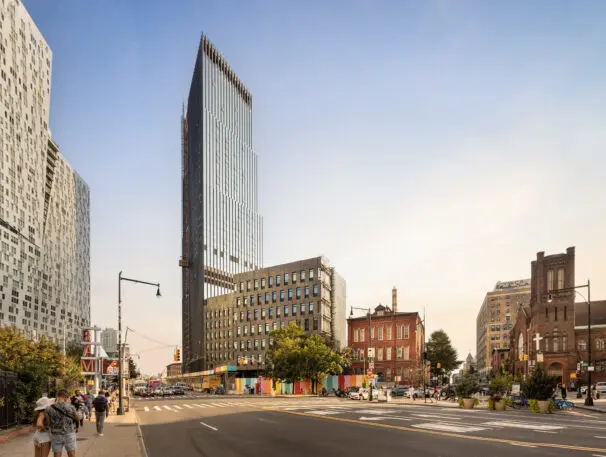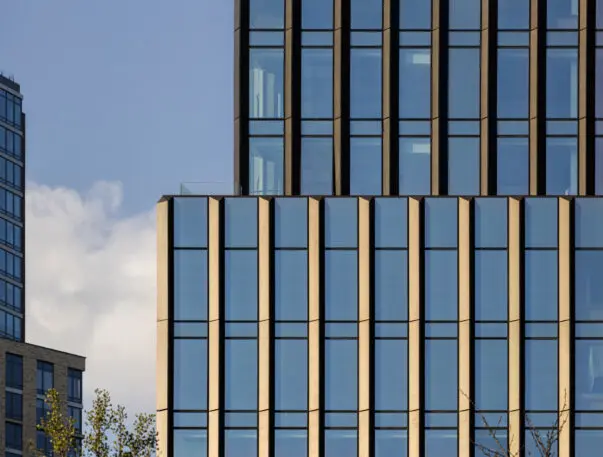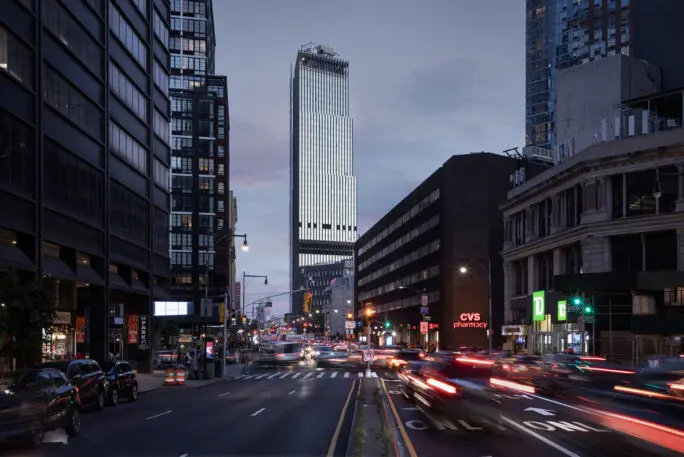When it opens to residents this spring, the 44-story tower at 505 State Street in Brooklyn will be a vision of future buildings to come. The skyscraper will be powered fully by electricity and burn no fossil fuels on site, making it the first tower in New York City to do so. In a world where gas burning stoves remain commonplace and gas furnaces still heat most homes, it’s a climate-conscious approach to building design that feels years, if not decades, ahead of its time.
But according to its designer and developer, this anomaly of a building wasn’t actually difficult to pull off. It was just a matter of reducing the amount of electricity the building needed to function and then finding the right equipment to consistently provide that energy without relying on anything but the grid.
The building is a project of New York-based Alloy Development, a rare real estate development firm that consists mostly of architects. In addition to taking on the financial risk to develop their projects, they also design them. With a set of principles centered around sustainable development, the company focuses on achieving carbon neutrality in its projects. The tower at 505 State Street is part of a larger block-sized development project that Alloy has been working on for eight years. The decision was made early on to make the 440-unit tower all electric, even if the path to getting there was not quite clear at the time.

All-electric single family homes are not uncommon, especially at the higher end of the housing market. But replicating that at the scale of 440 apartments required that Alloy’s designers and engineers think about the building’s systems more holistically. They realized that on-site renewable energy production, building-wide energy efficiency, and in-unit appliances were all interconnected sustainability efforts. Reducing the overall energy load though those interconnected paths would allow electrification to scale up. Once that was established as the solution, they just had to figure out how to do it.

“The primary engineering problem to solve was domestic hot water,” says Jared Della Valle, CEO of Alloy Development. The amount of hot water needed for 440 apartments is not insignificant, and the equipment required to heat that water is typically massive—and reliant on burning gas to generate the energy they require. “On the big building scale side of the equation, there wasn’t a whole lot of equipment available,” Della Valle says.

To make use of the electricity-powered alternative equipment for heating water, the designers needed to reduce the amount of hot water the building would need. This turned out to be a much more straightforward proposition. “The best way to achieve sustainable outcomes or efficiency outcomes is through high performance building envelopes,” says Della Valle. Better insulated exterior walls and triple glazed windows became a way to dial down the building’s energy demands. “The less you need air conditioning and the less you need heating, the less energy you’ll use overall, and therefore we can reduce the size of our systems and get them to a place, from an engineering perspective, where we can create enough hot water and enough energy to satisfy those demands,” Della Valle says. “It’s really not that complicated at the end of the day.”

Things have changed a lot since the building was first conceived. New laws and regulations are pushing the building industry away from status quo practices and toward designs and technologies that reduce or eliminate carbon emissions. At the federal level, the Inflation Reduction Act of 2022 calls for a dramatic decarbonization of the energy and building sectors, among other environmental targets. In New York City Local Law 97 will soon require buildings larger than 25,000 square feet to keep their carbon emissions below certain thresholds. These regulations are turning projects like an all-electric skyscraper from design dream to required reality. Partnerships with utilities, such as 505 State Street’s purchase of solar energy from Con Edison, will help buildings hit these targets.
Change is also underway at the consumer level. One lucky shift in consumer preferences has helped Alloy chip away at the electricity its building will require. In contrast to the recent past, gas stoves are no longer an expectation from some in the housing market. “Electric cooking as a desire is a new thing,” says Della Valle. That’s made it easier to create housing in this project that relies on new, highly efficient cooking appliances that don’t need gas. “Generally, the market is moving toward induction cooking as a preference,” Della Valle says. Every unit in the building has an induction cooktop.

When the building was first envisioned, Della Valle says it felt possible to do, if not exactly easy. Roughly five years later as the building is nearing completion, the market conditions, regulations, and, importantly, tools to pull it off are increasingly accessible. “The technology started to come toward us,” he says.

But that’s more than a set of fortuitous circumstances, he argues. Given the years it can take to get a building built and the decades it will stand, responsible designers and developers should be planning their projects for the conditions of the future.
“We’re building a building for 100 years, so we can’t make decisions based on the context we see now,” Della Valle says. “We have to make decisions based on the context we see ahead of us.”
Recognize your brand’s excellence by applying to this year’s Brands That Matter Awards before the early-rate deadline, May 3.
